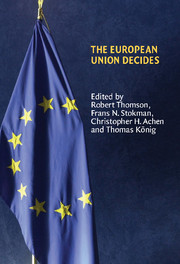Book contents
- Frontmatter
- Contents
- List of figures
- List of tables
- Notes on contributors
- Preface
- 1 Explaining legislative decision-making in the European Union
- 2 Research design: measuring actors' positions, saliences and capabilities
- 3 Testing procedural models of EU legislative decision-making
- 4 Institutional realism and bargaining models
- 5 Compromise, exchange and challenge in the European Union
- 6 Nash versus Schelling? The importance of constraints in legislative bargaining
- 7 A cooperative approach to decision-making in the European Union
- 8 A procedural exchange model of EU legislative politics
- 9 Beyond informal compromise: testing conditional formal procedures of EU decision-making
- 10 Evaluating political decision-making models
- 11 Evidence with insight: what models contribute to EU research
- Appendix I Selection of Commission proposals
- Appendix II Comparison of expert judgements with each other and with information from Council documentation
- References
- Index
- Title in this series
3 - Testing procedural models of EU legislative decision-making
Published online by Cambridge University Press: 22 September 2009
- Frontmatter
- Contents
- List of figures
- List of tables
- Notes on contributors
- Preface
- 1 Explaining legislative decision-making in the European Union
- 2 Research design: measuring actors' positions, saliences and capabilities
- 3 Testing procedural models of EU legislative decision-making
- 4 Institutional realism and bargaining models
- 5 Compromise, exchange and challenge in the European Union
- 6 Nash versus Schelling? The importance of constraints in legislative bargaining
- 7 A cooperative approach to decision-making in the European Union
- 8 A procedural exchange model of EU legislative politics
- 9 Beyond informal compromise: testing conditional formal procedures of EU decision-making
- 10 Evaluating political decision-making models
- 11 Evidence with insight: what models contribute to EU research
- Appendix I Selection of Commission proposals
- Appendix II Comparison of expert judgements with each other and with information from Council documentation
- References
- Index
- Title in this series
Summary
INTRODUCTION
The view that institutions are important to decision-making has led to a large number of game-theoretical models that aim to understand and explain the European Union's legislative process. As these models stress the sequential features of the legislative process as well as the differences in decision-making power of the various actors involved, they are referred to as procedural models. Departing from the ‘older’ legislative procedures, such as the consultation procedure (Steunenberg 1994a; Crombez 1996) and the cooperation procedure (Tsebelis 1994; Moser 1997a), this literature has expanded to include the more recently adopted procedures, including the two different versions of the co-decision procedure (Garrett 1995; Crombez 1997, 2000a; 2006; 2000c; Steunenberg 1997). In this chapter, we focus on the procedural models developed for the European Union and test some of these models empirically.
The procedural models of EU decision-making are related to a broader rational choice literature in which political outcomes are regarded as the combined result of political preferences and institutions (Shepsle 1989; Shepsle and Weingast 1995; Ostrom 1986; Dowding 2002). This literature developed as a response to studies, especially focused on the United States Congress, which approached politics as a simple account of majority rule. The main expectation from these studies was that voting cycles might frequently occur, which would make politics chaotic and arbitrary, and make it almost impossible to predict outcomes.
- Type
- Chapter
- Information
- The European Union Decides , pp. 54 - 85Publisher: Cambridge University PressPrint publication year: 2006
- 27
- Cited by



